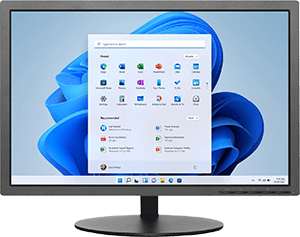Join RDI on Wednesday, Oct. 22, at 11 am to Learn the Cybersecurity Proactive Playbook to Secure Your Business
Upgrading to Windows 11
Post Date:

Microsoft Is Releasing Windows 11
Microsoft has announced that Windows 11 will be released on October 5, 2021! It will be rolled out in phases with the goal to have it available for all eligible devices by mid-2022. The rollout will start with new eligible devices and then extend to other in-market devices based on hardware eligibility, reliability metrics, the device’s age, and more.
Highlights of Windows 11
Windows 11 is designed to be more user-friendly with a new look and comes with some new tools, sounds, and apps. With a new Start menu and Snap Layouts, Windows 11 is designed to make your workflow easier than ever.
Microsoft is also proud to announce that Windows 11 is their most secure version yet! With security features such as hardware-based isolation, secure boot, and hypervisor code integrity turned on automatically, Windows 11 will better protect you from cyber threats such as malware and viruses.
Unlike previous Windows versions, for you to take advantage of all the new features and the increased security, Windows 11 has minimum system requirements that your devices must meet to install Windows 11.
Minimum Requirements:
According to Microsoft, your device must have the following to successfully install Windows 11:
- CPU: 1 gigahertz (GHz) or faster with two or more cores on a compatible 64-bit processor or System on a Chip (SoC)
- RAM: 4GB
- Storage: 64GB or larger
- System Firmware: UEFI, Secure Boot capable
- TPM: Trusted Platform Module (TPM) version 2.0
- Graphics Card: Compatible with DirectX 12 or later with WDDM 2.0 driver
- Display: High definition (720p) display that is greater than 9” diagonally, 8 bits per color channel
- Internet: Windows 11 Home edition requires internet connectivity and a Microsoft account to complete device setup on first use

Minimum Requirements:
According to Microsoft, your device must have the following to successfully install Windows 11:
- CPU: 1 gigahertz (GHz) or faster with two or more cores on a compatible 64-bit processor or System on a Chip (SoC)
- RAM: 4GB
- Storage: 64GB or larger
- System Firmware: UEFI, Secure Boot capable
- TPM: Trusted Platform Module (TPM) version 2.0
- Graphics Card: Compatible with DirectX 12 or later with WDDM 2.0 driver
- Display: High definition (720p) display that is greater than 9” diagonally, 8 bits per color channel
- Internet: Windows 11 Home edition requires internet connectivity and a Microsoft account to complete device setup on first use
Do I Have To Buy New Devices?
Before you panic about needing a new device, there is some good news. First, Microsoft will continue to support Windows 10 until October 14, 2025. This gives you about four years to make the switch to Windows 11. Secondly, Microsoft is doing testing and working on expanding the number of current devices that can support Windows 11.
If you need devices, the time to buy may be now due to ongoing chip shortages and an anticipated devices constraint near the release of Windows 11. There are currently known, compatible units available. Please contact us today for equivalent replacements!
Business Device Compatibility List
Below is a list of common, current hardware that exists in business, education, and government environments. Some of the hardware listed are compatible, and some are not. As Microsoft and vendors complete testing, this list will likely be added onto. Check back periodically to see what devices are added.
If you have one of the devices listed that is not compatible with Windows 11, please reach out to RDI. RDI will help you develop and implement a plan for switching to Windows 11.


